This exhibition at the Museum of Fine Arts in Ghent, which centres on the newly cleaned exterior panels of the Ghent Altarpiece, seeks to define ‘an optical revolution’; it is certainly a revelation. The sheer presence of so many works by Jan van Eyck, the artist Vasari claimed (incorrectly) to have invented oil painting – no fewer than 13 of only 22 works generally given to his hand are here – would by itself have assured a compelling exhibition. But the curators and the design team have deployed this raw material to maximum effect; their thoughtful and often bold choices create enlightening, sometimes unexpected juxtapositions, along with near perfect conditions for close looking.
We are confronted by Van Eyck’s painted surfaces, and a lot of them, in astonishing condition and dazzling in the density of their number, with what feels like no filter between his brush and our experience. Yellowed varnish and overpaint have been removed on a remarkably high proportion of these works over the last decade or two, not just on the famous Holy Lamb. Individually these recently conserved works have all had an effect on scholarship and our understanding of the artist; but their presence here in such close proximity, side by side, multiplies that impact many times over. Just 10–20 years ago, the same display would have created a rather different image of Van Eyck’s surfaces and his wider vision (how did we not realise we were looking but through a glass darkly?).
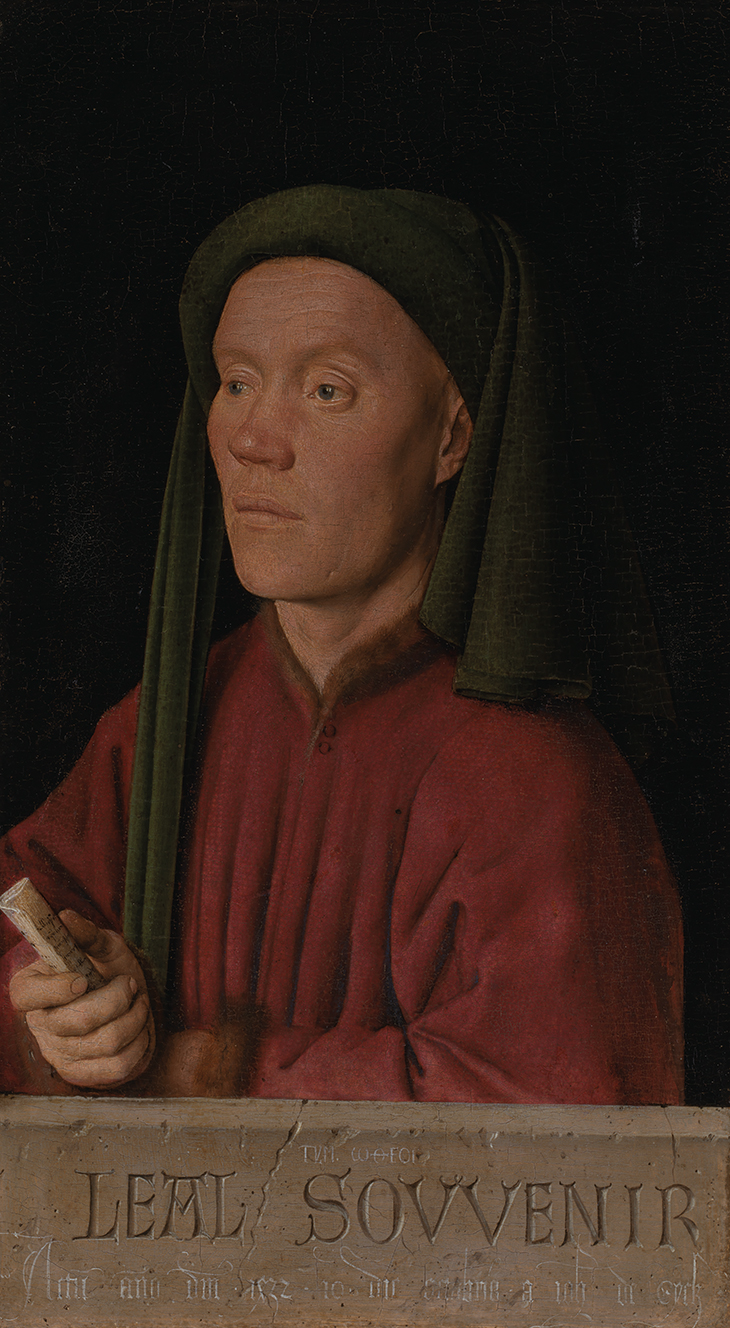
Portrait of a Man (‘Leal Souvenir’) (1432), Jan van Eyck. National Gallery, London
The ‘old’ Van Eyck would perhaps have been less able to carry the weight of argument made here concerning his scientific understanding of optics. If there was indeed an optical revolution in how he saw the world and translated it into paint, it has been made newly comprehensible by the patience and skill of the conservators who have cleaned these surfaces: the Leal Souvenir, in which the figure now has eyebrows and catchlights and a small scar on his chin, and the portrait of Baudouin de Lannoy, whose robes glisten along with his alert gaze, are among the most dramatic reveals – here set against a surface, unseen since the 16th century, of the figures of Joos Vijd and Elisabeth Borluut from the Ghent Altarpiece. The observation of the play of light across skin is breathtaking in these works, and how it was achieved remains in large part very hard to explain, though this show goes some way in attempting to do so: observation, rather than any technical revolution, is at its heart.
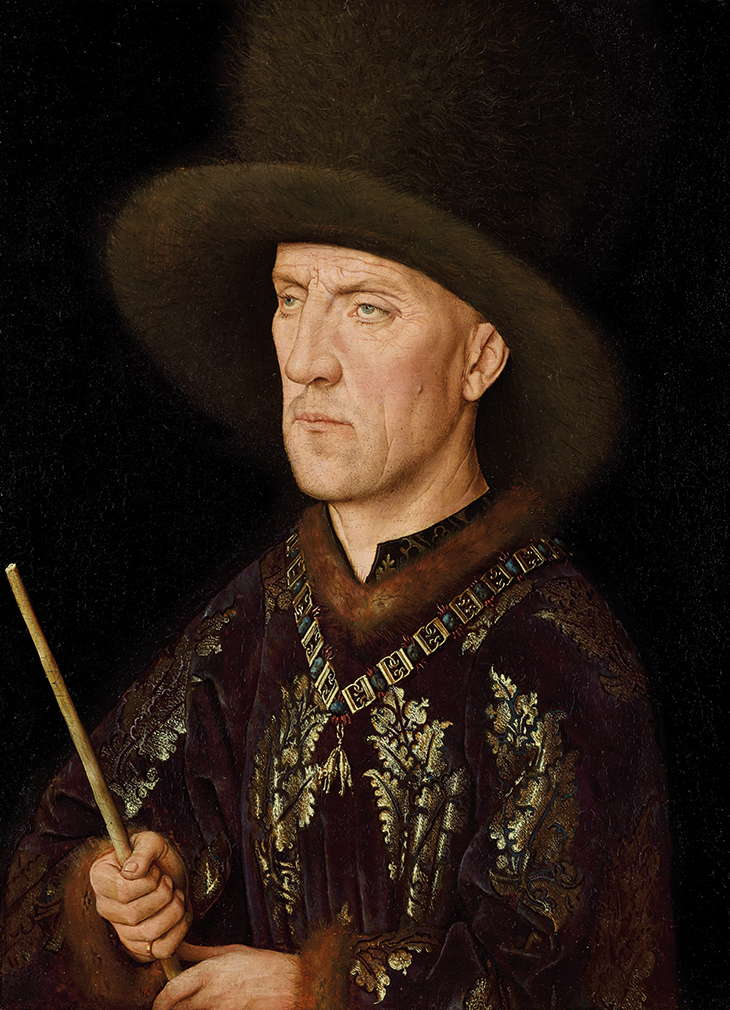
Portrait of Baudouin de Lannoye (c. 1435), Jan van Eyck. Photo: © KIK-IRPA, Brussels
We have become more used to seeing the detail in Van Eyck’s paintings digitally, through the Closer To Van Eyck website (closertovaneyck.kikirpa.be), recently augmented to include all but one of the works generally accepted as by him, with accompanying technical photography undertaken and generously shared by the VERONA project. But this illusion of proximity is seductive, and potentially deceptive, as this exhibition dramatically reveals: there is nothing to compare with the experience of his works, face to face, in all their material complexity.
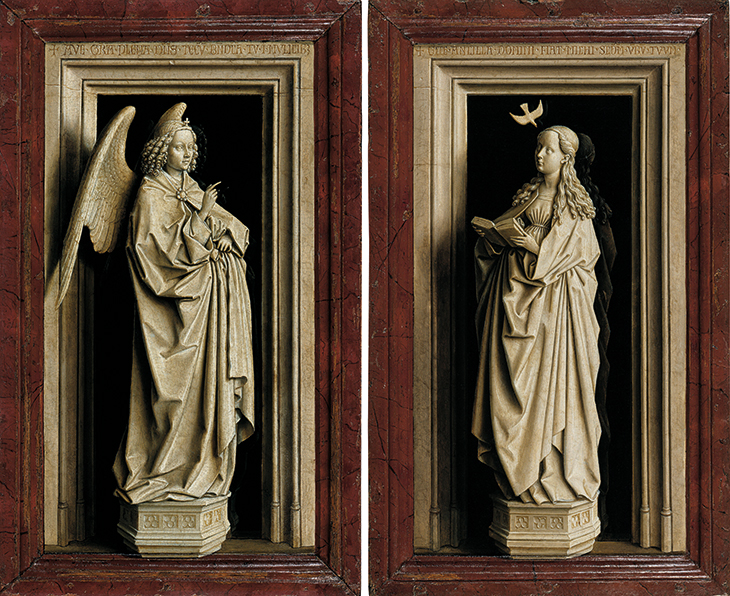
Annunciation Diptych (c. 1435), Jan van Eyck. Museo Nacional Thyssen-Bornemisza, Madrid
That may be true for most great artists but with Van Eyck the presence of his works seems particularly revelatory. In part this is because they were conceived as three-dimensional objects, their frames vital to their meaning, clarifying their message and transforming them materially; with their painted reverses they are made to look like durable and precious stones such as porphyry or jasper (the Annunciation Diptych and Saint Barbara), and impossibly heavy, as in the apparently pitted blocks of weathered masonry joined with fictive cement that enclose the exterior panels of the Ghent Altarpiece. This illusionistic frame is one of the more unexpected revelations provided by its cleaning: the complexity of its technique involving metal leaf and translucent glazes now newly discovered, its form previously indecipherable and presumed to be a later repaint. But scale, as well as material illusion in Van Eyck, also seems to matter more than for other painters. His works frequently trick you, or your memory; paintings are smaller or larger than expected. Adam and Eve still surprise with their monumentality, while the shrinking scale of the two St Francis panels, the small one in Turin and the even smaller, almost palm-sized version (on parchment stuck to panel), in Philadelphia, cannot be conveyed in reproductions, even those to scale. Seeing them together here and comparing their surfaces is another highlight.
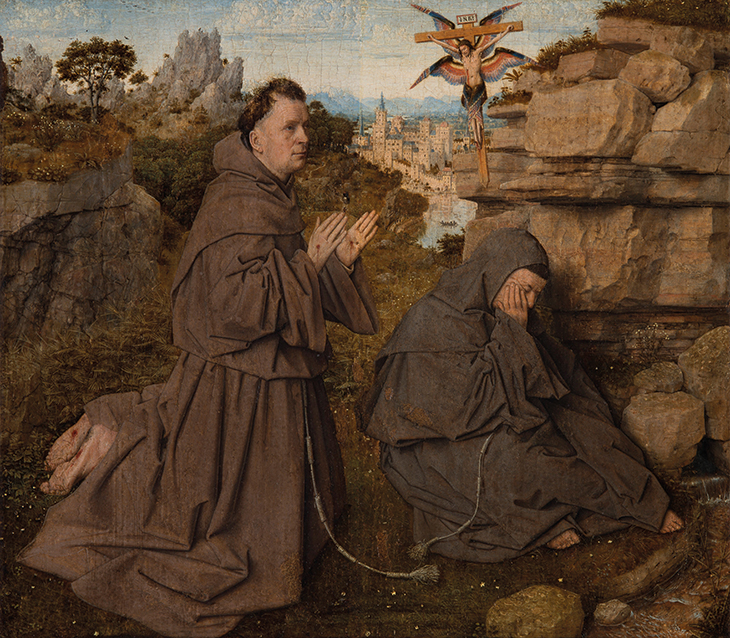
Saint Francis Receiving the Stigmata (c. 1435–40), Jan van Eyck. Galleria Sabauda, Turin
The density of the experience of Van Eyck’s achievement that the viewer takes from this show is not immediately apparent. We are confronted in the first room by a monumental tapestry and documents (the former a visual feast; the latter made comprehensible and legible by the careful display), then there is a room about historical context (the Burgundian court, Van Eyck’s geographical landscape) followed by one about Van Eyck’s reputation, from the writer Bartolomeo Fazio in the 1450s to the 19th century and beyond. Next is a rather fun but intelligent display of contemporary objects that are depicted in Van Eyck’s works – lustre tiles, a brass basin and a candlestick – all set against an animated video projection of his paintings. It is not until the fifth room that the first Van Eyck appears, but from there his presence builds to a crescendo as the show progresses, culminating in a room of portraits where there is but one solitary ‘contextual’ work (a rather lonely and alarmingly large profile portrait by Michele Giambono) among seven of Van Eyck’s masterpieces.
The boldest decision in this show is its most successful: the curators have exploited the structure of the exterior of the Ghent Altarpiece to disperse its panels and hang them separately, spread throughout a series of themed rooms, and multiplying its presence (one object has become 10). Although we lose the opportunity to view the restored exterior as a complex but unified and dramatic whole, we gain a once-in-a-lifetime chance to see these panels, particularly those from the upper register, up close – really close. They are set low, behind non-reflective glass, and without any alarm system, enabling you to stand eye-to-eye with the Annunciate Virgin or Joos Vijd. Once they return to Saint Bavo’s Cathedral, in whatever new system of display, it seems unlikely such proximity will ever be possible again. What a contrast this is with the unsatisfactory experience of viewing the newly cleaned central panel of the Adoration of the Lamb, back in its green-tinged glass box in Saint Bavo’s, separating us from any appreciation of its surface by several feet. It can only be lamented that politics (presumably) meant that this panel could not be part of the show.
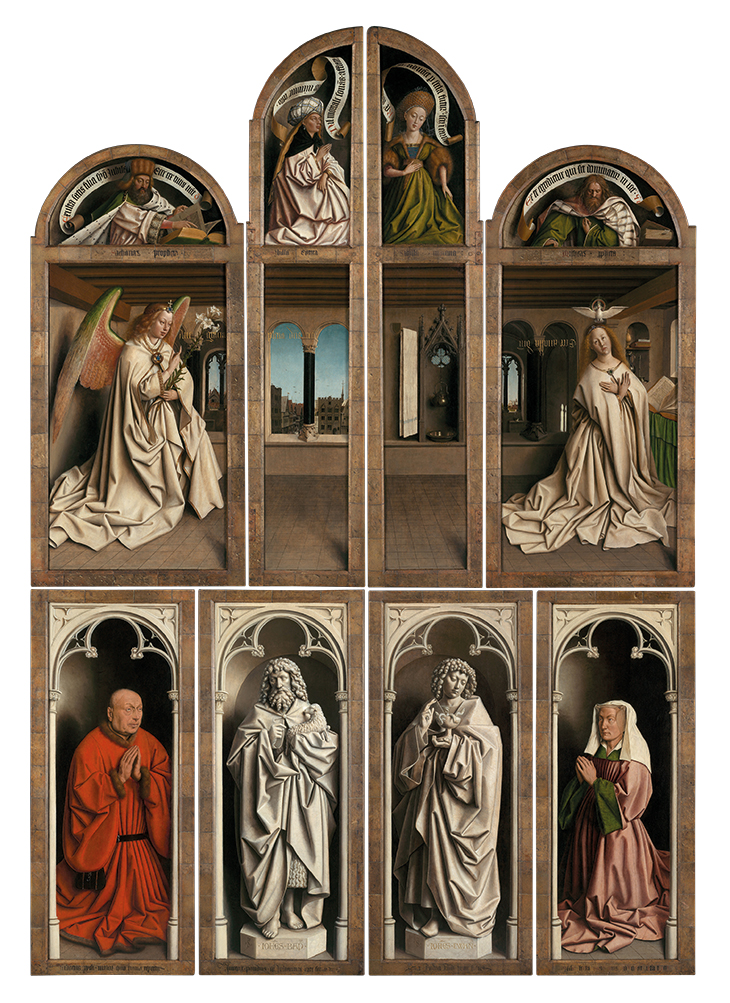
Ghent Altarpiece (exterior; 1432), Jan van Eyck. Photo: Dominique Provost; © www.lukasweb.be – Art in Flanders vzw
The separation of the altarpiece panels also enables them to be seen, for the first and surely last time, alongside other works painted by Van Eyck in the 1430s, and in dialogue with carefully selected objects with which they share particular affinities. They are thus presented here not as commissions for a particular chapel, patron or purpose, but as solutions to individual artistic problems: how to paint light, interiors and landscape; how to create the illusion of sculpture and its surface or of likeness in portraits; and how to paint the naked figure, in the as yet unrestored Adam and Eve – the only panels of the interior of the altarpiece shown here, since they were never sawn in two, unlike the rest of the wing panels. The context for these works in a section on ‘The Fall and Redemption’ is perhaps the least revelatory, but that is not the fault of the curators: quite simply there is nothing else in Van Eyck’s oeuvre that one could set next to his Adam and Eve (his other famous nude, described by Fazio, is now lost and known only through poor copies that are not in the show). By contrast the ‘Imitating Sculpture’ room is show-stopping, with the panels from the altarpiece that show the grisaille figures of the two Saint Johns, from its lower register, placed alongside a range of other Eyckian illusions of sculpture and architecture (including the Thyssen Annunciation and the diptych of the Virgin and John the Baptist from the Louvre) and in dialogue with carefully selected actual sculpture from the period, very similar in scale, in both alabaster and limestone.
The other bold decision has been to limit the contextual framework around Van Eyck. As a result, the show is almost entirely undiluted by the presence of other Netherlandish works that reveal his impact, or which might presage his achievements. We have either works by Jan and his workshop (which encompasses here works sometimes given to Hubert van Eyck and Petrus Christus) or those that can help us understand lost works by Jan van Eyck: copies after them, or versions that reflect them. The context for Jan’s ‘optical revolution’ is provided then not by direct competitors in the art of painting in the Netherlands, but through works by his direct contemporaries among painters in Italy, and more precisely, in most cases (if not all), from Florence: Masaccio, Fra Angelico, Domenico Veneziano, Gozzoli, Uccello. It is also given through a range of other media from the Netherlands that the painter was surrounded by: tapestries, manuscripts, sculpture and (to a regrettably lesser extent) metalwork. The rationale is, frequently, to emphasise difference rather than similarity, which makes for stimulating viewing. On first glance, for example, Fra Angelico’s Saint Francis Receiving the Stigmata might look almost cartoon-like in its lack of detail next to the exquisitely rendered surfaces in Van Eyck’s depictions, but the dramatic lighting the Florentine painter attempts (intriguingly absent from Van Eyck’s rendition of this scene about heavenly apparition), combined with the success of his composition, show this is far from the case. But the juxtaposition also reveals how different were the aims and purpose of the two artists: can Fra Angelico’s work, painted in egg tempera and part of a large-scale predella meant to be seen at a distance, really be compared with Van Eyck’s oil, intended for intimate contemplation and viewing? In some ways this show about ‘context’ removes it or ignores it, but in doing so allows us to focus on Van Eyck’s solutions to pictorial problems.
That Van Eyck was different and ‘new’ is a clear message throughout this exhibition; whether he would look quite as unique if set alongside the best works by the Master of Flémalle and Rogier van der Weyden from the same decades is another matter. Such comparisons might have provided a true test of the nature of his optical revolution, and a more stringent one than that provided by his contemporaries working in egg tempera in Florence. But in this extraordinary show one cannot begrudge Van Eyck his spotlight: maybe this is the perfect moment for him to be here, alone, in isolation from his local rivals.
From the March issue of Apollo. Preview and subscribe here.
The MSK Gent is temporarily closed to the public due to the Covid-19 outbreak. For more information on ‘Van Eyck: An Optical Revolution’ (scheduled to run until 30 April) visit the institution’s website.
Unlimited access from just $16 every 3 months
Subscribe to get unlimited and exclusive access to the top art stories, interviews and exhibition reviews.

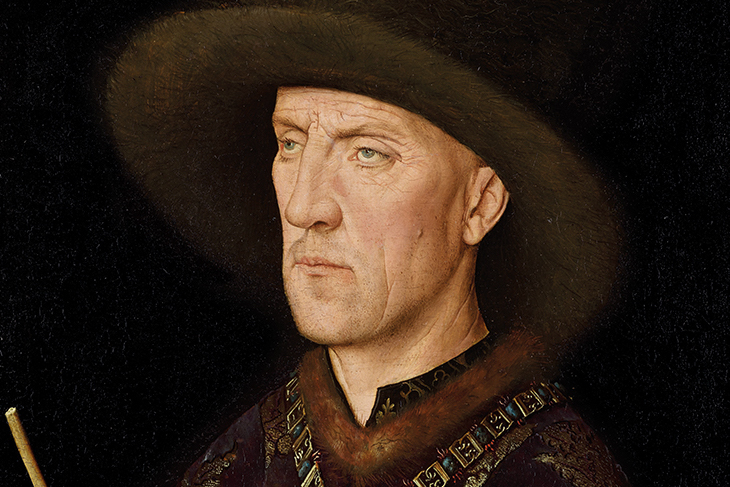
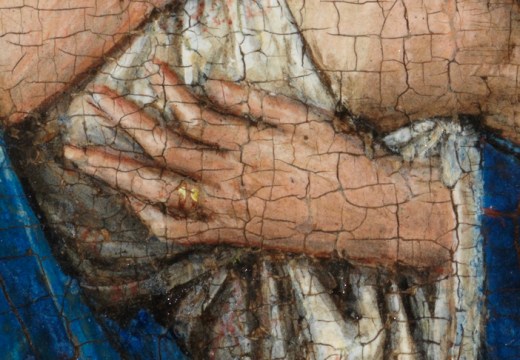
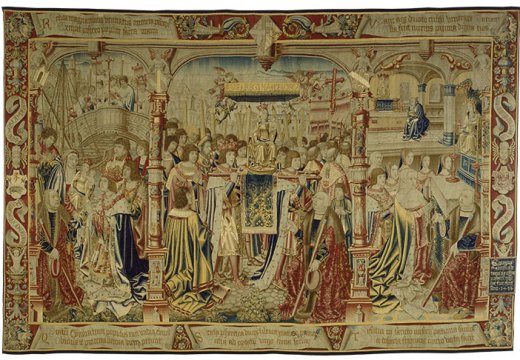
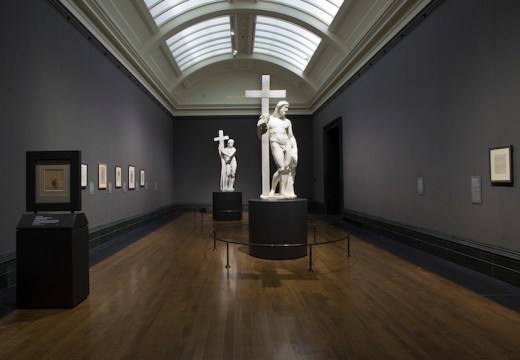









![Masterpiece [Re]discovery 2022. Photo: Ben Fisher Photography, courtesy of Masterpiece London](http://www.apollo-magazine.com/wp-content/uploads/2022/07/MPL2022_4263.jpg)
It’s time for the government of London to return to its rightful home